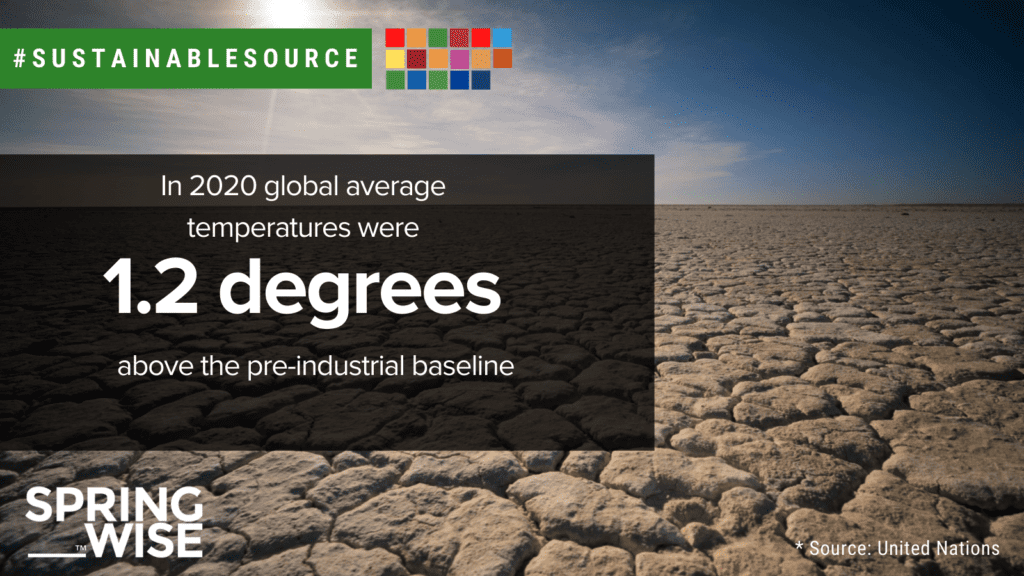In 1938, British scientist Guy Callendar demonstrated how records from nearly 150 weather stations showed that temperatures had risen over the past century – and that carbon dioxide levels had risen over the same period. At the time, meteorologists widely dismissed what was then called the ‘Callendar Effect’.
Today, the scientific evidence for man-made global warming is overwhelming, and climate change has emerged as the defining issue of our age. Greenhouse gas emissions are leading to rising temperatures, with scientists estimating that we have already caused warming of 1.2 degrees Celsius above pre-industrial levels. Limiting further temperature rises to 1.5 degrees could prevent the worst effects of global warming. But the world is not on track to meet this target.
The structural changes needed to limit climate change will require the collaboration of everyone in society, and necessitate action from society’s biggest stakeholders –notably governments. But innovation has a vital role to play in tackling this most existential of issues.
Understanding the impacts of climate change
If we are to effectively adapt to the reality of climate change and take action to limit its effects, it is crucial that we understand how temperature rises and extreme weather events will impact global eco-systems. Over the past decades, scientists have gathered an extensive body of research on the effects of climate change, but innovators continue to develop new ways to collect data on climate impacts. For example, a partnership between marine environment non-profit Beneath The Waves, and digital data experts Hexagon AB, is using airborne lasers to map seagrass meadows. This technique will allow researchers to track year-on-year changes and understand the role that these eco-systems play in the overall health of oceans. In the future, windborne sensors, could also be used to monitor climate change.
Climate models are also incredibly important for forecasting the impacts of a changing climate. Nividia is developing an advanced supercomputer for modelling the entire earth. The extremely high resolution of this ‘digital twin’ for the planet will enable the development of even more accurate models.

Education and awareness
Around the world, people have become accustomed to seeing and hearing news about climate change. Yet, despite this familiarity, innovators are coming up with new ways to prevent complacency and ‘climate fatigue’. One of the challenges of climate change as a policy issue, is that it can seem impersonal and intangible in our daily lives. Tackling the first of these issues is an app called ISeeChange. The app alerts users when weather in their area is abnormal, while also allowing them to share and discuss climate impacts and solutions.
A marketing campaign from Australian insurer Suncorp is tackling the issue of intangibility. Citing the statistic that only three per cent of disaster funding is spent on prevention, the company introduced a prototype home designed to withstand bushfires, floods, and cyclones – weather events that are becoming increasingly common because of climate change. The campaign provokes consideration about how and when the costs of increasingly common extreme weather events are borne.
Climate finance
The cost of tackling climate change will be considerable. And target 13.A within SDG 13 highlights the importance of providing financial support to developing countries to help them mitigate climate change. The target challenges developed countries to jointly mobilise $100 billion in finance per year from all sources – both public and private. Governments will be key in mobilising climate finance, but innovators also have a role to play – especially as the Climate Policy Initiative estimates that climate finance must increase by at least 590% to meet global climate objectives.
One company that is developing an innovative method for mobilising climate finance is Generate Capital. The firm partners with companies or communities to provide them with the capital to build sustainable infrastructure projects – such as geothermal power plants. Rather than raising private equity funds, which must usually be returned after ten years, Generate lets institutional investors by a stake directly in the firm, so that they can invest for the long term.

Adaptation and resilience
In addition to finding ways to limit further climate change, innovators are coming up with solutions that help to make communities more resilient in the face of the reality of rising temperatures. For example, a UN-backed project has developed an app that leverages advances in AI and smartphone technology to help farmers fight plant diseases linked to climate change. In an urban context, Czech startup ECOTEN has used geospatial data to create a temperature map of Vienna that the city will use to plan adaptations in response to the climate crisis.
Supporting vulnerable countries
The burden of climate change is not spread evenly across the globe, with developing countries, and small island nations particularly at risk. Solutions that are tailored to the needs of these communities—and that involve local people—are particularly crucial. For example, in Tanzania, a charity is teaching women to farm climate-resilient sea sponges to protect their income as fish stocks and seaweed cultivation are impacted by climate change.
Coral reefs are particularly important for the livelihoods of those living in coastal areas. Worldwide, an estimated one billion people benefit either directly or indirectly from the ecosystem services coral reefs provide. Sadly, coral eco-systems are among the most vulnerable to climate change with global coral cover falling by half since the 1950s. In response, Portuguese company Blue Oasis Technology has a plan to save the world’s coral by building engineered reefs.

Words: Matthew Hempstead
Know more innovations supporting SDG 13? Spread the word!
Sign up to the Sustainable Source newsletter to receive regular updates on the green innovations that matter and to get our insights into innovation and the SDGs direct to your inbox.
26th April 2022

